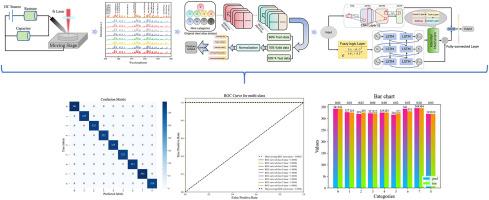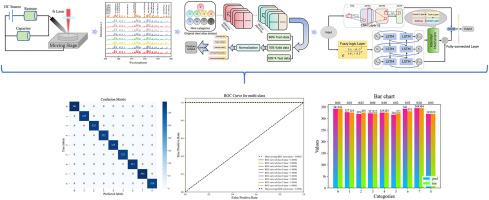FALCON-Net:一种混合模糊-关注lstm -卷积神经网络架构,用于飞秒激光烧蚀火花击穿光谱对钢合金进行高精度分类
IF 6
2区 化学
Q1 CHEMISTRY, ANALYTICAL
引用次数: 0
摘要
钢合金分类需要先进的方法来解决激光诱导击穿光谱(LIBS)中的光谱噪声,矩阵效应和非线性相互作用。本研究提出FALCON-Net,一种融合模糊逻辑、LSTM、注意力机制和CNN的混合架构,以增强基于lib的辨识。利用飞秒激光烧蚀火花诱导击穿光谱(fs-LA-SIBS),该模型处理了含有不同Cr、Mn、Ni、Cu、V、Mo和Al成分的九种钢合金的光谱数据。模糊层采用高斯函数来抑制噪声,而注意力引导LSTM捕获时间动态和临界波长。CNN提取空间特征,融合表征实现鲁棒分类。结果falcon - net在四个测试集上的准确率达到100%,ROC曲线的AUC得分为1.0,优于基准(RF: 97.89%, SVM: 97.23%)。在20 dB高斯噪声下,该方法仍能保持97.76%的准确率,具有良好的抗噪声能力。与传统的CNN-LSTM模型相比,计算复杂度降低了32%,而特征融合最大限度地减少了波长干扰,提高了稳定性。消融研究证实了模糊逻辑(准确性下降8.5%)和注意机制(下降3.2%)的必要性。增广光谱(5倍噪声变体)的训练增强了泛化性,每个样本的推断时间为0.5 s。对混合工业数据集(n=1,250个光谱)进行交叉验证,宏观f1得分达到99.2%,具有工业适用性。元素定量误差(例如,Cr: 0.12 wt%, Mn: 0.09 wt%)与ICP-OES参考值一致,验证了光谱的可解释性。在不同的烧蚀能量下,模型的精度为98%,进一步证明了模型的鲁棒性。本文首次将模糊逻辑和注意力增强深度学习集成到基于lbs的钢合金分析中。FALCON-Net的卓越性能凸显了混合架构在解决现实世界光谱挑战方面的变革潜力。通过提供高精度、抗噪声能力和计算效率,该框架为工业质量控制和材料表征提供了可行的解决方案,加速了fs-LA-SIBS技术在精密冶金中的实际实施。本文章由计算机程序翻译,如有差异,请以英文原文为准。


FALCON-Net: A hybrid fuzzy-attentive LSTM-convolutional neural network architecture for high-precision classification of steel alloys via femtosecond laser-ablation spark-induced breakdown spectroscopy
Background
Steel alloy classification demands advanced methodologies to address spectral noise, matrix effects, and nonlinear interactions in laser-induced breakdown spectroscopy (LIBS). This study proposes FALCON-Net, a hybrid architecture integrating fuzzy logic, LSTM, attention mechanisms, and CNN to enhance LIBS-based identification. Utilizing femtosecond laser-ablation spark-induced breakdown spectroscopy (fs-LA-SIBS), the model processes spectral data from nine steel alloys with distinct Cr, Mn, Ni, Cu, V, Mo, and Al compositions. The fuzzy layer employs Gaussian functions to suppress noise, while attention-guided LSTM captures temporal dynamics and critical wavelengths. CNN extracts spatial features, and fused representations enable robust classification.
Results
FALCON-Net achieves 100 % accuracy across four test sets, with ROC curves yielding perfect AUC scores (1.0), surpassing benchmarks (RF: 97.89 %, SVM: 97.23 %). Under 20 dB Gaussian noise, it maintains 97.76 % accuracy, validating noise resilience. Meanwhile, the feature fusion technique reduces wavelength interference and improves model stability.
Significance
This work presents the first integration of fuzzy logic and attention-enhanced deep learning for LIBS-based steel alloy analysis. The exceptional performance of FALCON-Net highlights the transformative potential of hybrid architectures in addressing real-world spectroscopic challenges. By offering high accuracy and noise resilience, the framework provides a viable solution for industrial quality control and material characterization, accelerating the practical implementation of fs-LA-SIBS technique in precision metallurgy.
求助全文
通过发布文献求助,成功后即可免费获取论文全文。
去求助
来源期刊

Analytica Chimica Acta
化学-分析化学
CiteScore
10.40
自引率
6.50%
发文量
1081
审稿时长
38 days
期刊介绍:
Analytica Chimica Acta has an open access mirror journal Analytica Chimica Acta: X, sharing the same aims and scope, editorial team, submission system and rigorous peer review.
Analytica Chimica Acta provides a forum for the rapid publication of original research, and critical, comprehensive reviews dealing with all aspects of fundamental and applied modern analytical chemistry. The journal welcomes the submission of research papers which report studies concerning the development of new and significant analytical methodologies. In determining the suitability of submitted articles for publication, particular scrutiny will be placed on the degree of novelty and impact of the research and the extent to which it adds to the existing body of knowledge in analytical chemistry.
 求助内容:
求助内容: 应助结果提醒方式:
应助结果提醒方式:


